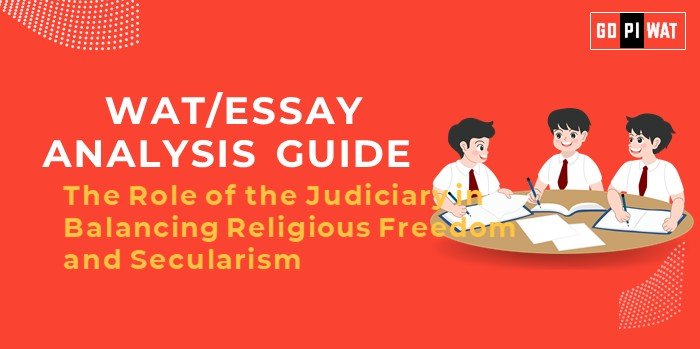📋 WAT/Essay Analysis Guide: The Role of the Judiciary in Balancing Religious Freedom and Secularism
🌐 Understanding the Topic’s Importance
The judiciary’s role in navigating religious freedom and secularism is vital in maintaining the balance between constitutional ideals and societal diversity. This topic connects deeply with ethics, governance, and social harmony, which are key themes in management and policy education.
⏳ Effective Planning and Writing
- Time Allocation:
- Planning: 5 minutes
- Writing: 20 minutes
- Review: 5 minutes
- Preparation Tips: Focus on Articles 25-28 of the Indian Constitution and identify landmark judicial cases like the Triple Talaq verdict.
📝 Introduction Techniques for Essays
- Contrast Approach: Highlight the tension between religious autonomy and state neutrality, e.g., “India’s secular fabric often contends with the complexity of safeguarding diverse religious freedoms.”
- Solution-Based Approach: Begin with a judicial case that resolved a significant religious-secular conflict, like the Sabarimala verdict.
- Timeline Approach: Trace the judiciary’s evolving role in balancing religious and secular mandates from independence to the present.
📚 Structuring the Essay Body
🏆 Achievements:
- Judicial precedents ensuring gender equality and secularism, such as the Triple Talaq case and the Sabarimala verdict.
- Decisions promoting minority rights, ensuring harmony in a pluralistic society.
⚖️ Challenges with Comparative Analysis:
- Tensions over uniform civil code debates and religious personal laws.
- Contrast with France’s strict secularism model, which bans overt religious symbols in public spaces.
🚀 Future Outlook:
- Greater emphasis on mediation and stakeholder dialogue in contentious cases.
- Judicial training on multicultural and intersectional perspectives.
✨ Concluding Effectively
- Balanced Perspective: “The judiciary’s success in balancing religious freedom with secularism lies in its ability to adapt interpretations to evolving societal needs.”
- Global Comparison: “India’s judiciary, like its global counterparts, faces the challenge of aligning constitutional ideals with diverse societal norms, offering lessons for pluralistic democracies worldwide.”
📊 Analyzing Successes and Shortcomings
- Key Achievements: Promoting gender equality, protecting minority rights, and safeguarding constitutional principles.
- Ongoing Challenges: Addressing political interference, navigating public backlash, and managing judicial resource constraints.
- Global Context: Compare with cases from the European Court of Human Rights, which has ruled on similar issues of religious expression.
💡 Recommendations for Sustainable Progress
- Promote stakeholder dialogues in contentious cases.
- Increase judicial training on multicultural perspectives to enhance sensitivity to diverse religious contexts.
- Develop clearer legal frameworks to evaluate public order vis-à-vis religious practices.
📄 Sample Short Essays
⚖️ Balanced Perspective:
“The judiciary safeguards secularism by interpreting constitutional mandates to balance religious freedom while ensuring societal harmony. However, a proactive approach to stakeholder involvement can enhance its role in a pluralistic democracy.”
✅ Solution-Oriented Approach:
“Judicial mediation offers a path forward, blending respect for religious practices with a commitment to constitutional ideals, thus reducing conflicts and fostering unity.”
🌍 Global Comparison:
“India’s judiciary mirrors global challenges in balancing religious rights and secular values, offering valuable insights into how diverse democracies can uphold both constitutional and societal commitments.”


